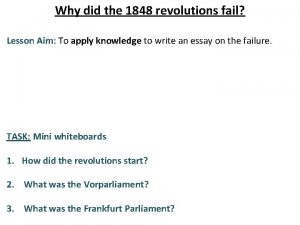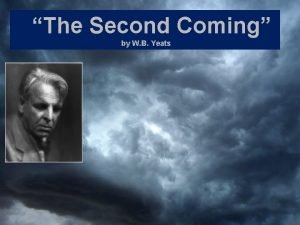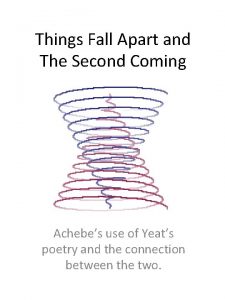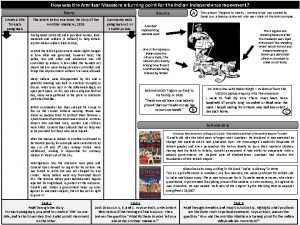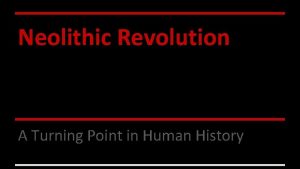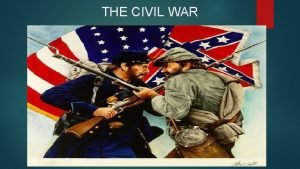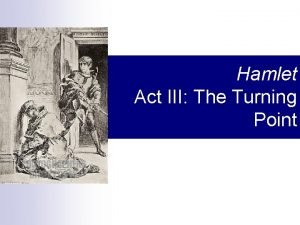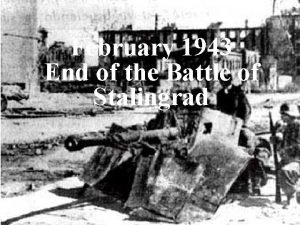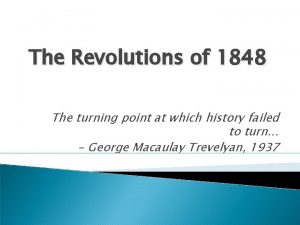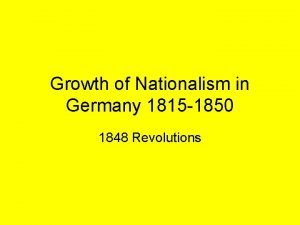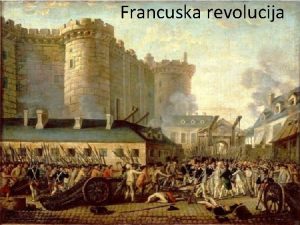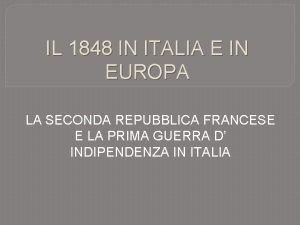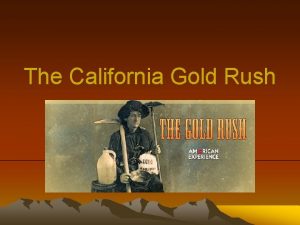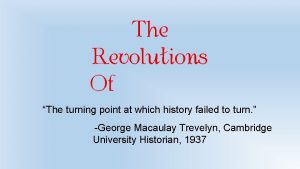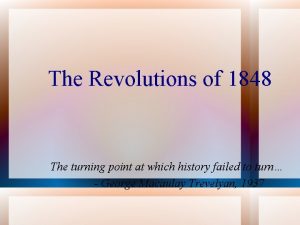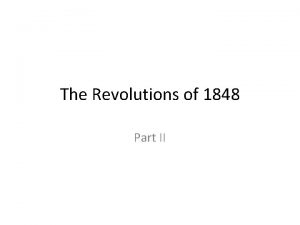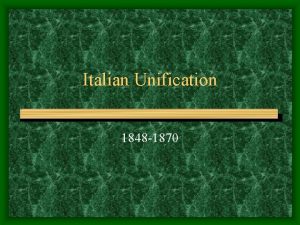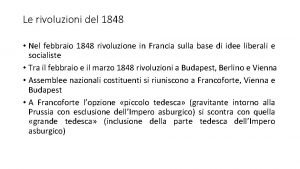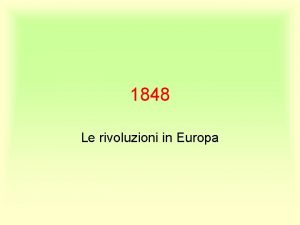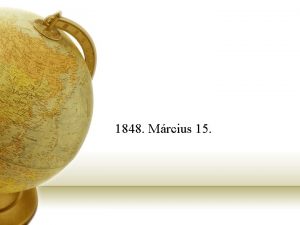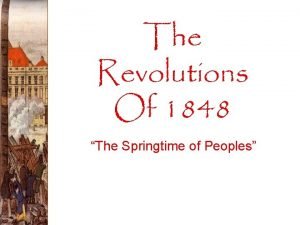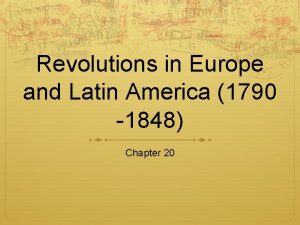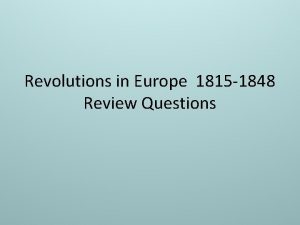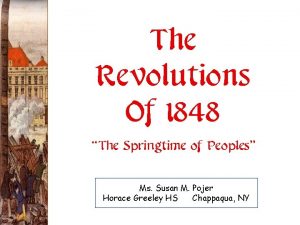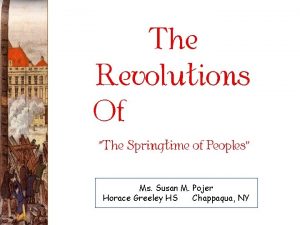The Revolutions of 1848 The turning point at

































- Slides: 33

The Revolutions of 1848 The turning point at which history failed to turn… - George Macaulay Trevelyan, 1937

Prince Metternich 1815: We have redrawn Europe’s map for eternity.

Not Really Mr. Metternich: Centers of Revolution in 1848

Historicism The “Hegelian Dialectic” ◦ History advances through conflict. ◦ One phase of history creates its opposite [ex: absolutism to democracy]. Thesis George Wilhelm Friedrich Hegel [1744 -1803] Antithesis Synthesis

I. Causes of upheaval Considered the watershed political event of the 19 th century. 1848 revolutions influenced by romanticism, nationalism, and liberalism, as well as economic dislocation and instability. Only Britain and Russia avoided significant upheaval. Neither liberals or conservatives could gain permanent upper hand. Resulted in end of serfdom in Austria and Germany, universal male suffrage in France, parliaments established in German states (although controlled by princes & aristocrats), stimulated unification impulse in Prussia and Sardinia-Piedmont. Last of liberal revolutions dating back to the French Revolution

Pre-1848 Tensions: Long-Term A. Industrialization ◦ Economic challenges to rulers. ◦ Rapid urbanization. ◦ Challenges to the artisan class. B. Population doubled in the 18 c ◦ Food supply problems Malthus C. Ideological Challenges ◦ Liberalism, nationalism, democracy, socialism. D. Romanticism E. Repressive Measures ◦ Carlsbad Decrees [Prus. ] ◦ Six Acts [Eng. ] ◦ Secret police created in many European states.

Pre-1848 Tensions: Short-Term A. Agricultural Crises ◦ Poor cereal harvests prices rose 60% in one year. ◦ Potato blight Ireland Prices rose 135% for food in one year! Corn Laws repealed as a result B. Financial Crises ◦ Investment bubbles burst railways, iron, coal. ◦ Unemployment increased rapidly [esp. among the artisan class]. Working & middle classes are now joined in misery as are the urban and agricultural peasantry!

II. France 1848: The February Revolution Working class and liberals unhappy with King Louis Philippe, esp. his minister Francois Guizot (who opposed electoral reform). King dismisses Guizot, but riots break out. King forced to abdicate on Feb. 24. Francois Guizot

Louis Philippe, “The Pear, ” 1848

The Provisional Government Second French Republic declared by Chamber of deputies. Moderate republicans led by liberal Alphonse Lamartine (allied w/ bourgeoisie) Socialists led by Louis Blanc national workshops created by Blanc to provide work for the unemployed Reforms: abolished slavery in the empire, 10 hr workday in Paris, abolished death penalty. April elections for new Constituent Assembly resulted in conflict between moderate republicans (who won) and socialists

Alphonse Lamartine A. A poet & liberal, he believed in the “Rights of Man. ” ◦ To vote, to free speech, to property, & to a secular education. B. Declared a new Provisional Government. ◦ Conservatives & liberals are suspicious of republicanism Reminiscent of the Reign of Terror.

Louis Blanc A. A Social Democrat. B. He believed in the “Right to Work. ” ◦ National Workshops. Provide work for the unemployed. C. Financial Crisis ◦ Flight of capital. ◦ Stock market crashes [55% decline]. ◦ New 45% increase of taxes on the peasants.

The June Days Revolt Workers attempted to create a revolutionary republic after Blanc was dropped from assembly. Results in “June Days” Revolution Cause: gov’t closed national workshops Marked beginning of class warfare in France Workers sought war against poverty and redistribution of income. Barricades put up in streets to oppose gov’t forces (Hugo’s Les Miserables based on this)

Paris: To the Barricades Again!

France 1848 The Second Republic (1848 -1852) General Louis Cavaignac: assumed dictatorial powers & crushed revolt (10, 000 dead) Victory for conservatives Nov 1848 – constitution provided for elected president and onehouse parliament Election of 1848: Louis Napoleon Bonaparte “Dark Horse Candidate” (1803 -1873) defeated Cavaignac 1852: Louis Napoleon consolidates power and becomes Emperor Napoleon III Louis Napoleon Bonaparte

The Austrian Empire: 1830

III. Revolution in Austria, 1848 Habsburg empire was vulnerable to revolutionary challenge Ethnic minorities sought nationalistic goals: Hungarians, Slavs, Czechs, Italians, Serbs, Croats, and others. (More non-Germans than Germans lived in the empire) Austrian gov’t was reactionary; liberal institutions were non-existent. Social reliance on serfdom doomed masses of people to a life w/o hope. “February Revolution” in France sparked rebellion for liberal reforms.

Austrian Students Form a Militia

Vienna, 1848 March 13 – rioting breaks out in Vienna Austrian empire collapsed; Metternich fled Constituent assembly meets. Serfdom (robot) abolished, revolution withers. Revolutionary gov’t failed to govern effectively Ferdinand I abdicates, Habsburgs restored royal absolutism under Franz Joseph (r. 1848 -1916). Franz Joseph

The Hungarian Revolution

Louis Kossuth (1802 -1894) Hungarian (Magyar nationalist)Hungary, leader demanded independence. March laws provided for Hungarian independence. Austrians invade, Hungarian armies drove within sight of Vienna. Slavic minorities resisted Magyar invasion and Hungarian army withdrew Austrian and Russian armies defeated Hungarian army. Hungary would have to wait until 1866 for autonomy 1848 Louis Kossuth

Bohemia, 1848 Prague Conference developed notion of Austroslavism: constitution and autonomy within Habsburg empire. Pan-Slav Congress failed to unite Slavic peoples in the empire. Austrian military ultimately attacked Prague and occupied Bohemia and crushed rebellion.

The “Three Germanies”

IV. The German States, 1848 Revolutions inspired by 1848 revolutions in France Liberals demanded constitutional government and a union or federation of German states. Frederick William IV rejected liberal constitution; imposed conservative one that guaranteed royal control of gov’t (lasted until 1918). Frederick William IV

Frankfurt Parliament Liberal, romantic, & nationalist leaders called for elections to a constituent assembly, from all states in the German Bund, for the purpose of unifying the German states. Sought war with Denmark to annex Schleswig & Holstein; Prussia declared war on Denmark (Danish War) Presented constitution for a united German federation. Selected Prussian King Frederick William IV as emperor; he declined claiming “divine right of kings”

Collapse of the Revolution Debate over whether or not to include Austria and who would rule (Hollenzollerns or Habsburgs? ) Failure of Prussia and Austria to support unification movement resulted in its collapse Frederick William’s attempt to unify Germany ended in failure, he dissolved the Parliament and created a constitution of his own for Prussia. This created a two-house parliament, but gave the king ultimate authority.

Collapse of the Revolution Prussia attempted to create a north German confederation that it would dominate. Austria opposed, demanding Prussian allegiance to the Bund (that Austria dominated) Nov. 1850 - “Humiliation of Olmutz”: Prussia dropped plan to unify Germany, leaving Austria as dominant German state in the Bund. Prussia would seek revenge in 1866 (Austro. Prussian War)

V. Upheaval in Italy, 1848 Italian nationalists and liberals seek to end foreign domination of Italy Milan, Lombardy and Venetia seek expel Austrian rulers Bourbon rulers in Kingdom of Two Sicilies and House of Savoy in Sardinia-Piedmont grant liberal constitutions. Sardinia-Piedmont declared war on Austria. Beginning in May, revolutions suppressed.

Italy, 1848 Giuseppe Mazzini established Roman Republic in 1849 protected by Giuseppe Garibaldi Pope Pius IX forced to flee Austrian General Radetsky crushes Sardinia-Piedmont; regains Lombardy and Venetia. French troops take back Papal States. Victor Emmanuel II takes throne in Sardinia-Piedmont.

Italy, 1848 Causes for failure: ◦ Rural people did not support revolutions, focused mainly on urban middle classes. ◦ Revolutionaries not united, fear of radicals among moderates leads to collapse. ◦ Lack of leadership and administrative experience among revolutionaries. Giuseppe Garibaldi

VI. Britain, 1848 The Chartists ◦ Movement reached its height with the Kennington Common demonstration on April 10, 1848. ◦ Could have been the prelude to revolution in Britain, but meeting was peaceful. ◦ Leaders did not follow-up on the meeting and Chartist movement died. Kennington Common demonstration on April 10, 1848

VII. 1848 – The Consequences The revolutions failed to pull popular support from working classes. Middle classes led the revolution, but as it turned more radical, they held back. Were they were successful, old guard was left in place and they turned against them. Nationalism divided more that united. Some gains lasted (abolition of serfdom, etc. ) In the long-term, most liberal gains would be solidified by the end of the century, Germany and Italy would be unified, and the Austrian Empire would collapse at the end of World War I.

The Bottom Line It looked like the Conservative forces had triumphed. BUT… ◦ Things had changed forever. ◦ Economic/social problems continued to be constant challenges to the ruling order. ◦ Conservatives would have to make concessions in order to stay in power. ◦ Many of the limited Liberal achievements remained permanent.
 Why did the 1848 revolutions fail
Why did the 1848 revolutions fail Indignant desert birds meaning
Indignant desert birds meaning Turning and turning in the widening gyre
Turning and turning in the widening gyre Things fall apart the second coming
Things fall apart the second coming Maynooth library search
Maynooth library search Operation turning point
Operation turning point Turning point academy
Turning point academy Key features of a parabola
Key features of a parabola Why was the spanish american war a turning point
Why was the spanish american war a turning point Oedipus rex plot diagram
Oedipus rex plot diagram Why was the amritsar massacre a turning point
Why was the amritsar massacre a turning point Why was the neolithic revolution a turning point in history
Why was the neolithic revolution a turning point in history Confederate surrender day
Confederate surrender day The turning point of the civil war
The turning point of the civil war Gtech gettysburg
Gtech gettysburg Turning point of the revolutionary war
Turning point of the revolutionary war What is the turning point in act 3 of hamlet
What is the turning point in act 3 of hamlet Life on the move cnidarians answers
Life on the move cnidarians answers Turning point audience response system
Turning point audience response system Liberation of majdanek turning point
Liberation of majdanek turning point Elizabethan sonnet
Elizabethan sonnet Sonnet 130 meaning
Sonnet 130 meaning Trough in business cycle
Trough in business cycle Turning point suffragist memorial
Turning point suffragist memorial Revolution 1848 verlauf
Revolution 1848 verlauf Austrian empire 1848
Austrian empire 1848 Humiliation of olmutz
Humiliation of olmutz Francuska u 17 st
Francuska u 17 st Quadrilatero austriaco
Quadrilatero austriaco 1848-as dalok
1848-as dalok Leto 1848 in slovenci
Leto 1848 in slovenci Julska monarhija
Julska monarhija January 24, 1848
January 24, 1848 Bernhard bolzano
Bernhard bolzano
